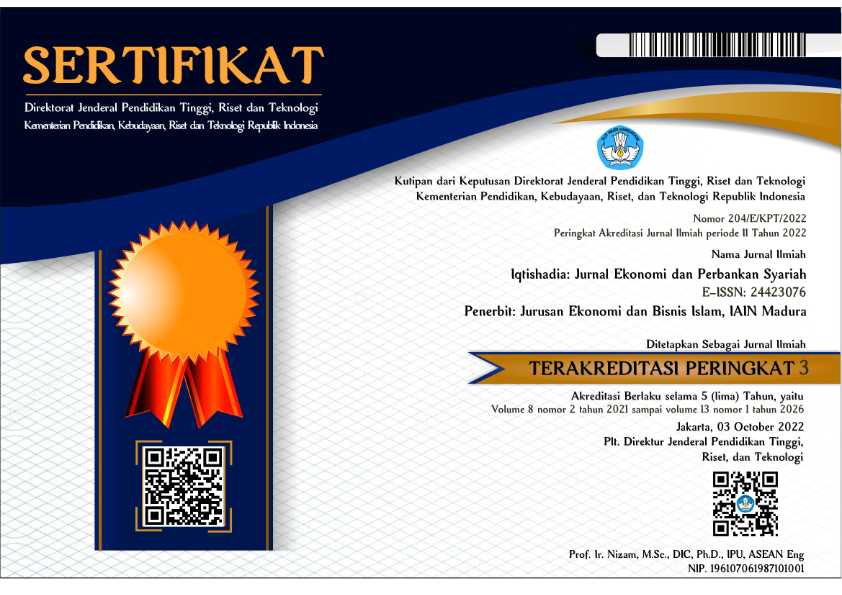Pengaruh Tunjangan Karyawan terhadap Kinerja Karyawan di Bank Pembiayaan Rakyat Syariah (BPRS) Bakti Artha Sejahtera (BAS) Sampang
 Abstract views: 600
,
Abstract views: 600
,
 PDF downloads: 441
PDF downloads: 441
Abstract
Downloads
References
Bilson Simamora, Riset Pemasaran, Falsafah, Teori dan Aplikasi. Jakarta: PT. Gramedia Pustaka Utama, 2004.
Cholid Narbuko dan Abu Achmadi, Metodelogi Penelitian. Jakarta: PT Bumi Aksara, 2009.
Departemen Agama RI, RobbaniAl-Qur’anperkata Tajwid Warna. Jakarta: PT. Surya Prima Sinergi, 2012.
Edwin B. Flippo, Manajemen Personalia Edisi Keenam Jilid 2 Alih Bahasa Moh. Masud. Jakarta: Erlangga, tt.
Indra Yana, Hak dan Kewajiban Karyawan. Jakarta: Raih Asa Sukses, 2010.
Iqbal Hasan, Analisis Data Penelitian dengan Statistik. Jakarta: Bumi Aksara, 2010.
Kaswan, Manajemen Sumber Daya Manusia untuk Keunggulan Bersaing organisasi. Yogyakarta: Graha Ilmu, 2012.
Lin Grensing-Pophal, Human Resorcerbook: Manajemen Sumber Daya Manusia untuk Bisnis. Jakarta: Prenada Media, 2006.
MalayuS.P Hasibuan, Manajemen Sumber Daya Manusia. Jakarta: PT Bumi Aksara, 2002.
Mudrajat Kuncoro, Metode Kuantitatif; Teori dan Aplikasi untuk Bisnis & Ekonomi, Edisi keempat. Yogyakarta: Unit Penerbit dan Percetakan Sekolah Tinggi Ilmu Manajemen YKPN, 2011.
Nanang Martono, Metode penelitian Kuantitatif Analisis Isi dan Analisis Data Sekunder Edisi revisi. Jakarta: PT. Raja Grafindo Persada, 2012.
R. Wayne Mondy, Manajemen Sumber Daya Manusia, Jilid 2 Edisi 10,. Jakarta: Erlangga, 2008.
Riduwan, Skala Pengukuran Variabel-variabel Penelitian Cetakan Keenam. Bandung: Alfabeta, 2009.
Sadili Samsudin, Manajemen Sumber Daya Manusia. Bandung: CV. Pustaka Setia, 2006.
Sudarmanto, Kinerja dan Pengembangan KompetensiSumber Daya Manusia. Yogyakarta: Pustaka Pelajar, 2009.
Sugiyono, Metode Penelitian Bisnis. Bandung: Alfabeta, 2009.
Suryani dan Hendryadi, Metode Riset Kuantitatif: Teori dan Aplikasi pada Penelitian Bidang Manajemen dan Ekonomi Islam. Jakarta: Kencana, 2015.
T. Hani Handoko, Manajemen Personalia dan Sumber Daya Manusia Edisi 2. Yogyakarta: BPFE, 2014.
Teguh Setiyadi, Bagian Umumdi PT. BPRS Bakti Artha Sejahtera Sampang, Wawancara Langsung. 15 Maret, 2016.
Wibowo, Manajemen Kinerja-Edisi Ketiga. Jakarta: PT Rajagrafindo Persada, 2013.
The journal operates an Open Access policy under a Creative Commons Non-Commercial Share-Alike license. All articles published Open Access will be immediately and permanently free for everyone to read and download.
• Creative Commons Attribution-NonCommercial (CC-BY-NC)

Iqtishadia: Jurnal Ekonomi dan Perbankan Syariah by http://ejournal.iainmadura.ac.id/index.php/iqtishadia is licensed under a Creative Commons Attribution-NonCommercial 4.0 International License.
Based on a work at http://ejournal.iainmadura.ac.id.


























